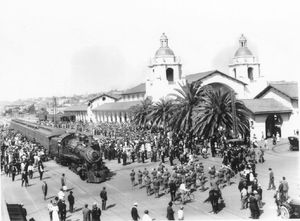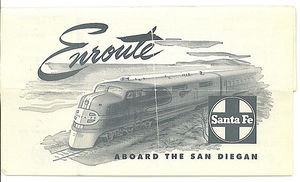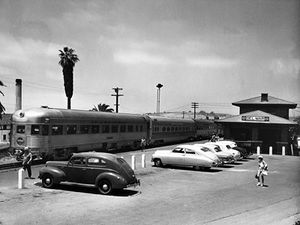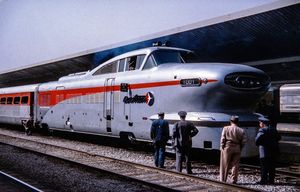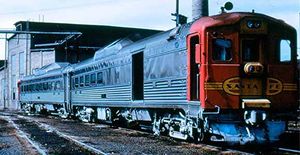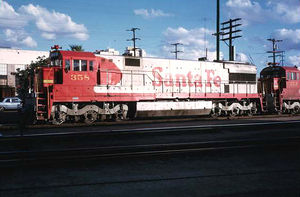San Diegan
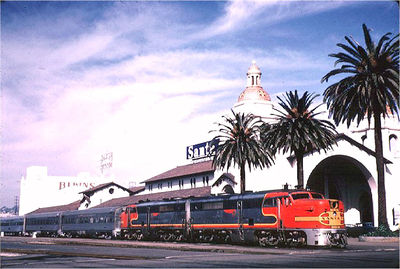
The San Diegan, led by a pair of back-to-back ALCO PA units, reaches the end of the line at San Diego's Union Station on October 26, 1963. The facility, constructed in the Mission Revival Style in support of the Panama-California Exposition, officially opened on March 18, 1915.
The San Diegan was one of the named passenger trains of the Atchison, Topeka and Santa Fe Railway (AT&SF). A true "workhorse" of the railroad, its 126-mile (203-kilometer) route ran from Los Angeles, California south to San Diego. Inaugurated on March 27, 1938, it was assigned train Nos. 70–79 (Nos. 80–83 were added in 1952 when Budd Rail Diesel Car [RDCs] began operating on the line). The Los Angeles-San Diego corridor (popularly known as the "Surf Line" — officially, the Fourth District of the Los Angeles Division) was to the Santa Fe as the New York–Philadelphia corridor was to the Pennsylvania Railroad. Daily traffic could reach a density of ten trains (each way) during the summer months. The first San Diegan ran on March 27, 1938 as one set of equipment making two round trips each way.
A second trainset delivered in 1941 made possible four streamlined trains each way. Soon thereafter, an additional third set of heavyweight equipment made a fifth trip in each direction possible. During and after the Second World War, furlough business from San Diego's military bases necessitated extra (albeit heavyweight) sections of San Diegans, and racetrack specials during horse racing season at Del Mar added to passenger train miles. Amtrak continued to operate the San Diegan when it took over operation of the nation's passenger service on May 1, 1971, ultimately retiring the name on June 1, 2001. Today the route of the San Diegan (the second busiest rail line in the United States of America) is served by Amtrak's Pacific Surfliner.
History
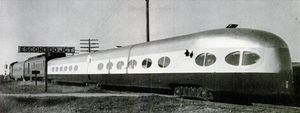
An experimental Hill pendulum-suspension (articulated) passenger car undergoes testing on Santa Fe's "Surf Line" trackage near Escondido Junction in early 1940.[1] The operating rules in effect at the time required that markers be mounted on the rear of the car.
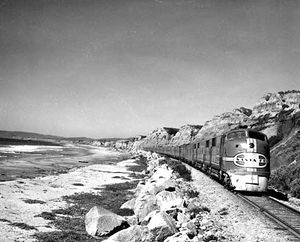
The San Diegan, powered by a pair of EMD E1 locomotives, rolls south along the Pacific Coast through San Clemente.
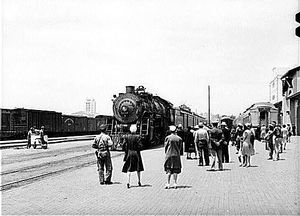
The station platform at San Diego in the early days of World War II. The Valley Flyer, filling in as train No. 70, the San Diegan, is at the right. The local train from Los Angeles is just pulling in with No. 3749 on the head end.
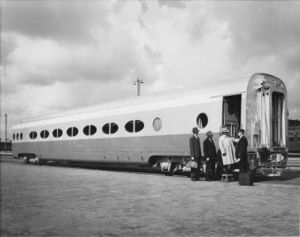
AT&SF chair car #1100, the railroad's distinctive, lone oval-window 56-seat pendulum coach. Santa Fe took delivery of the smooth-sided unit in November, 1941.[2] Delivered in two-tone blue with a silver roof (the only car so painted to match the Santa Fe's "Blue Goose" streamlined 4-6-4 Hudson steam locomotive), the car was completely repainted in silver in 1945.
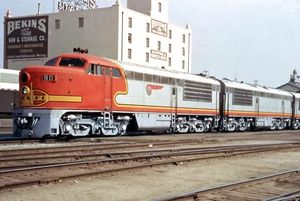
The lone A-B-A set of Erie-built locomotives built in May, 1947 for the Atchison, Topeka and Santa Fe Railway hauled a number of consists including those on the San Diegan.
Antecedents
- October 12, 1880: The California Southern Railroad Company is officially organized. Initial plans are made to construct 18 miles (29 kilometers) of main line track extending north from National City.[3]
- January 2, 1882: The California Southern begins regular passenger and freight service between its National City terminus and Fallbrook Junction, just north of Oceanside.[3]
- August 12, 1888: Santa Fe completes the "Surf Line" run between Los Angeles and San Diego under the auspices of its subsidiary, the California Southern. The line is initially referred to as the Los Angeles — San Diego "Short Line" as it replaces the circuitous inland route through Temecula Canyon.[4]
- January 13, 1913: Locomotive No. 1275 (a Baldwin-built 4-6-2), bound for La Grande Station' in Los Angeles, leads the Saint out of San Diego and derails as it descends the Sorrento Grade due to excessive speed. The engineer and 21 passengers are killed, and the fireman suffers a broken leg; all of the railroad equipment is essentially destroyed in the mishap. Public pressure is brought upon the railroad to construct a tunnel through the Soledad Mountains in order to guard against similar accidents in the future.[5]
- March 18, 1915: A new, Mission Revival Style facility officially opens in support of the Panama-California Exposition.
- 1924: The Santa Fe submits plans for the Soledad Tunnel to the California Railroad Commission for approval. Owing to a post–World War I backlog, it takes nearly a year for the Commission to review the request, which is ultimately denied due to fears that the technology did not yet exist to construct a structure that would withstand the effects of an 8.0 magnitude earthquake.
- April 25, 1925: Southbound train No. 76, led by Engine No. 1332 (a Baldwin 4-6-2), leaves the tracks while ascending the Sorrento Grade at virtually the same location that the 1913 derailment took place. As in the 1913 tragedy, most of the railroad equipment is either severely damaged or destroyed outright, though in this instance the only fatal injury is suffered by the engineer; it takes several days to clear the wreckage and reopen the line to traffic.
- 1936: The Santa Fe orders a six-car train from the Budd Company specifically for the initiation of San Diegan service.
- 1937: The Pacific Railway Equipment Company (PREC) manufactures a prototype articulated "pendulum-suspension" coach which employed a passive tilt system on curves in order to eliminate jounce. The articulated test car (constructed largely of plywood) consists of two separate carbodies joined by a shared center truck. Santa Fe agrees to test run the car on its trackage between Los Angeles and San Diego.
The San Diegan
- March 27, 1938: The Santa Fe inaugurates the San Diegan route, operating on a two hour and 45 minute schedule.[6]
- December 31, 1940: No. 1676, a 2-10-2 Santa Fe type locomotive with a 40-car freight train in tow, jumps the rails while cruising north via the Sorrento Grade and lands in the Pacific Ocean, with much of the rolling stock following suit. No one is killed in the accident, though it is many days before all of the wreckage can be pulled out of the sea.
- June 8, 1941: A second lightweight train consisting of six coaches, a baggage-mail car, a tavern lunch-counter car, and a round-end observation car is added to the line. Service is increased to four daily round trips utilizing streamliners and one round trip using conventional equipment.
- October 27, 1941: A fifth, steam-powered train is added to the schedule, due in part to the need to transport military personnel to and from San Diego's bases. This "semi-streamlined" train carries a full buffet car, a diner, and three coaches that had all previously run as the Valley Flyer between Oakland and Bakersfield.[7] The number of daily trains servicing the route increases to 16, on average.
- November 1941: The railroad's sole Pullman-built "pendulum-suspension" coach is delivered and is placed into service with the San Diegan.
- 1942: The average number of trains per day increases to 42. Consist size expands to 13 cars, and each logs 512 daily miles. Trains consisting of 10-12 former Southern Pacific-Pacific Electric non-electrified interurban cars, owned by the United States Maritime Commission but bearing ATSF markings, are fitted with conventional knuckle couplers at each end of the trainset and pressed into service to handle the additional passenger loads.
- April 18, 1942: A packed, northbound San Diegan collides with a local, steam-powered (Atlantic type No. 1468) freight train at the Orange Junction, located in the City of Orange. Several passengers receive minor injuries, and rail traffic must be rerouted via Atwood and the Olive District until the wreckage is cleared and the tracks repaired. Locomotives #3 and #3A are badly damaged in the incident.[8]
- May 13, 1942: Locomotives #2L and #2A, operating as the first section of train No. 73, strike a gasoline tanker at a grade crossing in Hobart. Both units are damaged by fire.[9]
- April 1943: The "over-the-road" time is lengthened to three hours due to ever-increasing military movements.
- May 10, 1943: Santa Fe adds a second mainline track along the San Diego line between La Mirada and Fullerton to accommodate increased wartime traffic. Centralized Traffic Control (CTC) is installed on the line.[10]
- December 14, 1943: Train No. 77 is struck by a tractor-trailer rig in Santa Ana. "Chair" car #3094 sustains damage in the collision.
- May 1952: Two Budd-built RDCs are put into express service. The twin 85-foot (26-meter) long units, which can carry 90 passengers each, make two daily round trips on a two hour and 15 minute schedule.
- August 23, 1953: Santa Fe 3751 pulls the last steam-powered trains (Nos. 72 and 73) on the "Surf Line."
- January 10, 1954: The use of round-end observation cars is discontinued in order to eliminate the need to "turn" the trains in San Diego before heading northward.
- January 25, 1954: The RDCs (running as train No. 80) strike a truck in Cardiff.
- February 11, 1954: The RDCs (making up train No. 81) collide with an automobile in Encinitas.
- October 14, 1954: RDC #DC191 strikes and automobile in Morena and sustains damage in the collision. RDC #DC192 operates solo as train Nos. 80 and 81 until repairs to its companion unit are completed at San Bernardino.[9]
- January 22, 1956: Bound for San Diego, the RDCs (making up train No. 82) derail in an evening high-speed accident at Redondo Junction, just south of the Los Angeles Union Passenger Terminal (LAUPT), killing 30 and seriously injuring 117. This was the units' last run on the "Surf Line." [11] The radio reports of this accident were one of the first major uses of the "Sigalert" (known at the time as a "Sigmon Traffic Alert").
- March 1956: General Motors' Aerotrain makes a series of experimental runs as a San Diegan consist. Thoughts of placing it in permanent service are quickly abandoned as the entire trainset has to be turned at each end of the line, and requires helper locomotives on the Sorrento Grade.
- April 28, 1956: Heavyweight local trains Nos. 70 and 75 are discontinued due to operational losses.
- Summer 1956: Santa Fe's El Capitan makes three demonstration runs to San Diego to promote its new "Hi-Level" cars. The railroad begins placing illuminated "drumheads" (formerly mounted on round-end observation cars) on the vestibule gate of the trailing cars of the San Diegan. Service on the line is reduced to six daily round trips.
- Summer 1958: Service is further reduced to five daily round trips and weekend extra trains.
- September 3, 1958: Train No. 70 strikes a motor truck at a grade crossing in San Juan Capistrano; locomotive #340L sustains moderate damage.[9]
- November 19, 1958: An F4D Skyray fighter jet overshoots the runway at the Marine Corps Air Station in El Toro and is struck by southbound train No. 74, which is traveling at 75 miles-per-hour. All three locomotives and cars #3430, #3165, #3144, #1399, #3100, #3094, #3082 derail. No fatalities and only a few injuries result.[9]
- January 14, 1959: Locomotive #20C, leading train No. 75, collides with a gravel truck at a grade crossing in Irvine: the unit sustains considerable damage and is "set out." [9]
- August 2, 1961: Train No. 76 strikes a gravel truck in Anaheim. Locomotives #339L-A-B and cars #3076, #3119, #3179, #3145, #3100, and #3158 are derailed.[9]
- October 29, 1962: Train No. 76 is struck by a gravel truck in Anaheim, derailing "chair" cars #3082, #3147, and #3146 on the Santa Ana River Bridge.[9]
- July 31, 1964: Mail trains Nos. 70 and 81 are dropped as all mail between Los Angeles and San Diego is now transported via truck (Santa Fe's mail contract expired on July 1st and was not renewed).
- 1965: Service is further reduced to three daily round trips (train Nos. 73–78) on a two hour and 55 minute schedule.[12]
- December 22, 1965: Train No. 76 collides with a gravel truck in Anaheim. Locomotives #61L and #51C, and cars #3084, #3156, #3152, #3179, and #3076 all derail.[9]
Amtrak
- May 1, 1971: Amtrak is formed and takes over operation of the San Diegan.[13]
- July, 1996: IC3 Flexliner is put into two-week trial service during the height of the Del Mar horse racing season.
- June 1, 2000: Amtrak retires the San Diegan and replaces it with the Pacific Surfliner, which runs between San Diego and San Luis Obispo, California.
Equipment
Motive power consisted of a single 1,800 hp EMD E1A locomotive sporting the Santa Fe's familiar Warbonnet paint scheme. These units would, in time, be replaced by ALCO PA and PB power, EMD F3, and EMD F7 locomotives. Santa Fe's lone trio of Fairbanks-Morse (FM) "Erie-built" locomotives and the odd GE U28CG could also be seen occasionally running the line. A lone pair of Budd-built 90-seat, self-powered Rail Diesel Cars (RDCs) were acquired for express service.They operated "back-to-back" as a single train unit from May, 1952 until their accidental destruction in January, 1956.
In 1938, the rolling stock delivered for the San Diegan consisted of all lightweight stainless steel cars built by the Budd Company. The equipment used was as follows: [14]
- Baggage-Mail car #3432
- "Chair" car / Coach (52 seats) #3070
- "Chair" car / Coach (52 seats) #3072
- "Chair" car / Coach (52 seats) #3089
- "Chair" car / Coach (52 seats) #3091
- "Chair" car / Coach (52 seats) #3137
- Tavern-Lunch Counter Diner #1398
- Round-end Parlor-Observation #3240
Three additional coach units were added for weekend traffic. The San Diegan also enjoyed almost exclusive use of Santa Fe's Pullman-built (PPS) experimental "pendulum-suspension" chair car, #1100. In June, 1941 the railroad added a second eight-car trainset, also built by Budd, to handle the high demand for passage aboard the train. Its original consist was similar to the above save for an additional coach. Subsequent consists varied according to the traffic levels.
A representative, all-lightweight consist from the Summer of 1955: [15]
- Baggage-Mail car
- Railway Post Office (RPO)-Baggage car
- "Chair" car / Coach (52 seats)
- "Chair" car / Coach (52 seats)
- "Chair" car / Coach (52 seats)
- "Chair" car / Coach (52 seats)
- Bar-Lounge-"Chair" car (#1398-#1399 assigned)
- "Chair" car / Coach (52 seats)
- "Chair" car / Coach (52 seats)
- "Chair" car / Coach (52 seats)
- "Chair" car / Coach (52 seats)
A representative, all-lightweight consist from the Summer of 1970:
- "Chair" car / Coach (44 seats)
- "Chair" car / Coach (44 seats)
- "Chair" car / Coach (44 seats)
- "Chair" car / Coach (44 seats)
- "Chair" car / Coach (44 seats)
- "Chair" car / Coach (44 seats)
- "Chair" car / Coach (44 seats) - Sat-Sun only
- "Chair" car / Coach (44 seats) - Sat-Sun only
- "Chair" car / Coach (44 seats) - Sat-Sun only
- "Chair" car / Coach (44 seats) - Sat-Sun only
- "Chair" car / Coach (44 seats) - Sat-Sun only
- "Chair" car / Coach (44 seats) - Sat-Sun only
- "Chair" car / Coach (44 seats) - Sat-Sun only
- "Chair" car / Coach (44 seats) - Sat-Sun only
A typical San Diegan consist under Amtrak in 1998:
- EMD F40PH #369
- EMD F40PH #372
- Baggage #9638
- Amfleet Coach #44206
- Amfleet Coach #54071
- Amcafé Diner City of Solana Beach
- Coach #44635
- Amclub "Custom Class" Coach #44839
Route and station stops
Santa Fe Los Angeles Division: Fourth District [16]
- Los Angeles Union Passenger Terminal
- Fullerton
- Anaheim
- Orange
- Santa Ana
- Galivan
- Irvine
- San Juan Capistrano
- San Clemente
- Fallbrook Branch
- Oceanside
- Escondido Junction
- Carlsbad
- Escondido Branch
- Encinitas
- Del Mar
- Sorrento Grade
- Miramar-Linda Vista Grade
- Moreno-Old Town
- Union Station (San Diego)
Notes and references
- ↑ LIFE Magazine, pp. 41-42
- ↑ Frailey, p. 169: The unit was retired in 1961. In this photo the car has yet to receive Santa Fe markings.
- ↑ 3.0 3.1 Duke (Volume One), p. 50
- ↑ Duke (Volume One), p. 242
- ↑ Duke (Volume One), pp. 278-279
- ↑ Jordan, p. 66
- ↑ Jordan, pp. 66, 68: The steam-powered, all-heavyweight consist was headed by 4-4-2 Atlantic type locomotive No. 1369 and included three coaches, a lounges, and a baggage-club car. A diner was added in 1941.
- ↑ Jordan (1996a), p. 9)
- ↑ 9.0 9.1 9.2 9.3 9.4 9.5 9.6 9.7 Joplin (1999), p. 22
- ↑ Jordan, p. 69
- ↑ Joplin (2000), pp. 8-10
- ↑ Duke (Volume Two), p. 359
- ↑ Duke (Volume One), p. 250
- ↑ Frailey, p. 165
- ↑ Frailey, pp. 166-168
- ↑ Duke (Volume One), pp. 252-272

